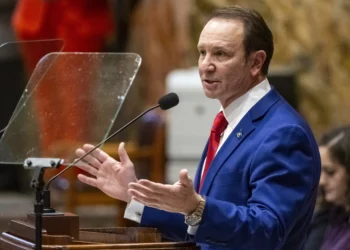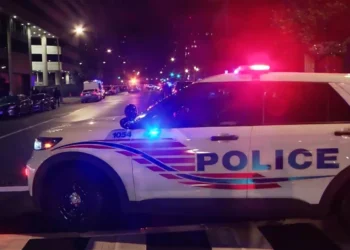The Real ID requirement takes effect Wednesday, but despite all the warnings about delayed summer plans if fliers don’t comply with the new identification card, enforcement has been delayed.
The Real ID Act was originally passed in 2005, but its implementation was delayed and is now slated to take effect today. However, Homeland Security Secretary Kristi Noem said Tuesday that people not complying with the new requirement will be “allowed to fly.” They may face additional security hurdles.
The law was intended to create a new federal standard for identification documents following the 9/11 terrorist attacks. Still, it’s caught many Americans by surprise despite years of federal government warnings to prepare for that date.
“The Real ID requirement bolsters safety by making fraudulent IDs harder to forge, thwarting criminals and terrorists,” said Adam Stahl, TSA senior official performing the duties of the administrator, in a statement. “TSA will implement Real ID effectively and efficiently, continuing to ensure the safety and security of passengers while also working to minimize operational disruptions at airports.”
Airport security checkpoints are not the only place Americans and lawful immigrants could find themselves in a predicament trying to enter.
What is the Real ID?
The law states that state- and territory-issued driver’s licenses and government-issued identification cards must meet new federal standards for the carrier to enter federal buildings and nuclear power plants, as well as board commercial aircraft.
It was put forward in Congress following the 9/11 terrorist attacks at the recommendation of the 9/11 Commission. The commission called for a streamlined federal standard for identification documents, given that there was none, and states could choose what documents they deemed necessary to issue a license or ID.
Andrew Meehan, the former acting secretary for public affairs at the Department of Homeland Security during the first Trump administration, said the goal of the law was to raise the standard for state-issued IDs.
“The 9/11 Commission rightfully recognized that state-issued driver’s licenses and identification cards play an integral role in everyday life,” Meehan wrote in a text message. “REAL ID set common sense standards that ensure the authenticity and integrity of state-issued IDs, making it more difficult for terrorists and other criminals to exploit loopholes in the identification process.”
The new requirements included requiring states and territories to have residents provide certain documents, including a Social Security number, birth certificate, and proof of address.
What is required for a Real ID?
IDs that are compliant with the law must also have a photograph of the applicant on the ID, store digital images of the documents the applicant provides, and verify documents against federal databases.
For example, a Social Security number provided to a state employee at a Department of Motor Vehicles, where most states issue licenses, has to be checked in real time against the federal Social Security Administration’s database.
Birth certificates must be verified through the National Association for Public Health Statistics and Information Systems’ Electronic Verification of Vital Events.
Immigration status must also be cross-checked against the DHS’s Systematic Alien Verification for Entitlements system.
States and territories issuing the new IDs must ensure that previous ID cards have been terminated by the same or a different state, limit the new document to a maximum eight-year validity period, run background checks on employees, and include a symbol on the top right corner of the ID that is provided to approved applicants.
Why is it only taking effect now?
The Real ID Act of 2005 was passed during former President George W. Bush’s second term and gave states three years to comply.
The law was supposed to be enforced by 2008, but the DHS pushed that initial implementation date back countless times, including due to pushback from states early on and the 2020 coronavirus pandemic.
David Bier, director of immigration studies at the libertarian Cato Institute think tank in Washington, opposes the Real ID Act on the basis that it goes beyond the federal government’s authority.
“Nothing in the U.S. Constitution authorizes the federal government to control identification documents for domestic travel. It is an affront to liberty and our Founders’ design to allow the federal government to usurp this power,” Bier wrote in an email, adding that no U.S. plane had been hijacked since 9/11 while there has not been an ID standard in place.
“Blocking or unduly burdening US citizens’ right to travel is unconstitutional,” Bier said. “Meanwhile, a nationalized ID system would enable nationwide surveillance and control of US citizens in a way heretofore impossible, which threatens the rights of everyone.”
The DHS has stated it is not attempting to build a national database with residents’ personal information.
“REAL ID is a national set of standards, not a national identification card. REAL ID does not create a federal database of driver license information. Each jurisdiction continues to issue its own unique license, maintains its own records, and controls who gets access to those records and under what circumstances,” the DHS said in a statement. “The purpose of REAL ID is to make our identity documents more consistent and secure.”
Is the public ready?
The Transportation Security Administration has played a leading role over the past year, notifying the public that identification cards must be replaced to be compliant when the law takes effect. However, because the effective date has been pushed back year after year so many times, it is likely to catch many by surprise just as the summer travel season begins, possibly setting up challenges at airport checkpoints.
“What will happen tomorrow is folks will come through the [airport security] line and will issue their ID and show it. If it’s not compliant, they may be diverted to a different line, have an extra step, but people will be allowed to fly,” Noem said at a House Appropriations subcommittee hearing Tuesday.
“We recognize that this is a security issue. Congress has had many, many years to reevaluate it and decide if they wanted to change the law or to stop it, and the Biden administration chose that it should go into place on May 7,” she added. “And we intend to follow the law, so we will make sure that it is as seamless as possible, and that travelers will get to stay on their intended itinerary.”
TSA has maintained it will efficiently process the high number of airline passengers during the summer months, even as the implementation kicks in, but that could be a challenge.
Approximately 81% of travelers passing through TSA checkpoints have a Real ID-approved ID, but 19% do not, according to the agency. That means of the 1.9 million to 2.8 million airline passengers passing through security checkpoints daily, roughly 380,000 to 560,000 are not ready for the requirement.
TRUMP ADMINISTRATION TO INSTALL 17 MILES OF BUOYS IN RIVER AT U.S.-MEXICO BORDER
Anyone under 18 with an adult companion is not required to comply with the new standard. Real ID-compliant IDs cannot be used as passports to cross into Mexico or Canada or board international sea cruises.
The only other exception at airports will be illegal immigrants who are boarding flights while self-deporting from the U.S., according to the TSA.

















